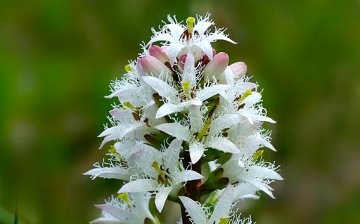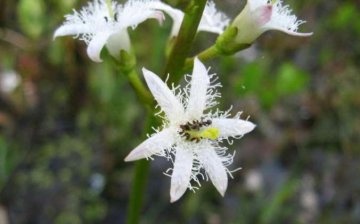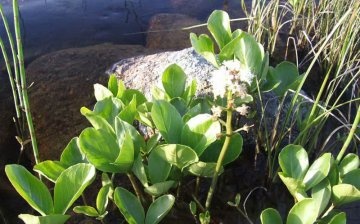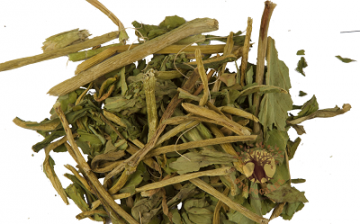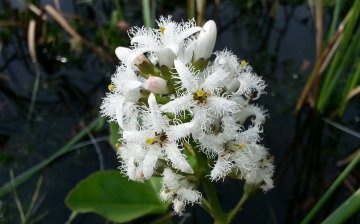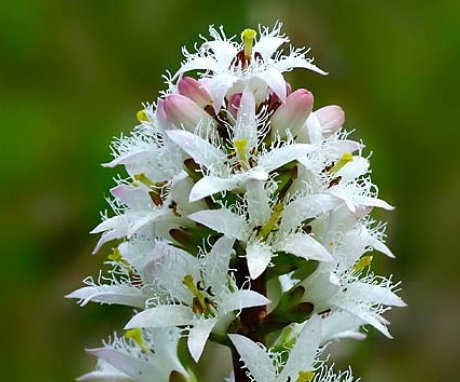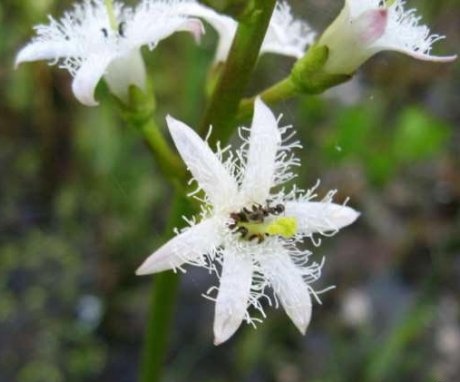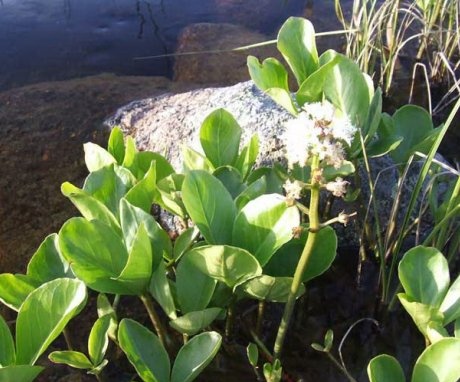Water shamrock: reproduction, planting, useful properties and use in medicine
The water shamrock is known for its medicinal properties. He, like a guardian, monitors the health of the owners and pleases with exquisite flowering on the water. The plant takes root well in fresh waters. It is used in landscape design as a green fence of the pond - the trefoil is located along the water edge of reservoirs.
Its aesthetic appearance and healing properties are widespread in many countries. The gardener will learn about the value of a plant and how to grow it in a home pond from this short guide.
Content
- Description of water shamrock
- Interesting Facts
- How to grow a plant
- Breeding methods
- Useful properties of watch leaves
- Application in medicine
Description of water shamrock
The plant has many names - three-leaf watch, watch, water shamrock, tripol or bean.
Perennial structure features:
- Represents perennial with a thick, creeping rhizome, which rises up at the end.
- Watch leaves are trifoliate, shiny and are formed in a raised rhizome of 2-3.
- The stalk of the peduncle is naked, without leaves.
- The plant blooms in May-June with inflorescences of a white or pale pink hue.
- Flowers are collected in a brush at the end of the peduncle stem.
- During the growing season, a seed capsule is formed with oblong fruits, slightly flattened. The box has a rounded shape similar to an egg.
Trefoil aquatic flowers are special. They are covered with fine villi and resemble fluffy paws. The fact is that this plant is capable of self-pollination in bad weather and rains. The villi are needed to prevent insects from pulling the pollen away.
The watch, thanks to the unusual flowers, has a very beautiful appearance when blooming.
The water shamrock is widespread throughout the European part of Russia, in western Siberia and in the Far East. The plant adapts perfectly to almost any climatic conditions. It is of particular value in folk and traditional medicine.
Interesting Facts
The traditional name of the plant, three-leafed watch, owes an interesting legend. It is very sad, but very popular among the peoples of many countries with various variations. The story is based on a girl picking cranberries in a swamp with her friend. Carried away by picking berries, she did not notice the quagmire and ended up in its very center. It was not possible to save the girl from inevitable death, no matter how her friend tried. After the tragedy, a plant with touching flowers grew on this place. Since then, it has been called the watch - by the name of the drowned woman.
Other stories tell again about a girl who drowned in a quagmire through the fault of an evil stepmother. One way or another, the name of the plant owes to the name of a girl who died in a swamp by accident.
Since then, the water shamrock is also called the guardian of the swamps, which warns that it is dangerous here.
The plant is widely used in landscape design and denotes the boundaries of a reservoir or an artificial swamp, as it happens in nature.It is grown on the edges of reservoirs for decorative shelter of the boundaries between land and water.
How to grow a plant
Like any aquatic plant, the watch requires a warm, fresh body of water. Moreover, it can be shallow water, shallow swamp. The main condition for growing will always be abundant soil moisture. For successful cultivation, trifol must be added to a pond or shallow water with a nutritious substrate or oily clay. The first one should be clean, free from foreign matter.
Try to germinate seeds in a warm and light reservoir. If the soil is nutritious and the pond is well warmed up, the water shamrock will grow rapidly with lush, beautiful blooms. Usually the plant is immersed in a basket with holes in the bottom. This allows you to control the location of the watch. When it dies, the container is simply taken out of the water, dried and put away until the next season.
Plant seeds are planted in spring.
Many growers germinate seed at home in aquariums or containers with silt and clay as substrate. So the plant will hatch faster and it can already be placed with the container in a pond or lake. The fruits of the watch are harvested closer to autumn, the main thing is not to watch them and collect them in time.
Growing the plant is simple as it does not require any additional maintenance procedures other than collecting leaves for medicinal purposes and seed pods for propagation.
Breeding methods
Besides natural reproduction - seeds - the trefoil can be diluted by dividing the rhizome. This is perhaps the most common way. Often gardeners acquire a young plant, which only needs to be placed in a reservoir in the right place for design.
The watch takes root quickly, especially if the pond is filled with nutritious soil.
The water is stagnant and begins to bloom early - this is an indicator of the high content of useful trace elements for plant growth. Seeds germinate for a long time and it is not a fact that they will germinate safely.
The plant grows very quickly and covers the entire coastal area of a pond or lake. Therefore, there are no special problems with reproduction by dividing by rhizome. Having grown the plant, the owner can collect the healing power of the leaves during the flowering period and after - June, July.
Useful properties of watch leaves
As a raw material for the preparation of decoctions or tinctures, the leaves of a plant in the stage of full maturation are used. It comes in June during and after flowering. It is not recommended to collect the apical and young leaves, they still have few useful substances and they darken when dried.
The useful properties of a watch include:
- Increased appetite
- Improving the functioning of the digestive tract
- Has a choleretic effect
- Calms the nerves
- Anti-inflammatory action
- Beneficial effect for flatulence and gastrointestinal disorders
In Bulgarian folk medicine, for example, the watch is considered one of the most effective plants in the treatment of gastrointestinal diseases. In Tibet, not only leaves are used, but also rhizomes. Applied for gastroenteritis. The broth is also used as a mild laxative.
The beneficial properties of the plant are undeniable and have been used in traditional medicine for many decades, in folk medicine - hundreds.
The leaves of the plant have a bitter taste due to the content of many bitter substances. Due to this, the trefoil infusion irritates the receptors and increases the appetite. The plant contains:
- Alkaloids
- Iridoid glycoside
- Betulinic acid
- Coumarin
- Flavonoids
Also, the composition is dominated by vitamin C, iodine and fatty oil. This plant can easily cope with diseases such as scurvy. Due to its chemical composition, the water shamrock effectively copes with the disorder of the digestive tract and all the ensuing consequences.Considering all the beneficial properties and composition, the infusion or decoction of the plant is used in both traditional and folk medicine.
Application in medicine
Watch leaves are harvested in summer. They are collected and dried in open, ventilated places until the veins and cuttings of the leaf begin to break easily. Raw materials are usually used as a hot infusion. Depending on the problem and disease, a certain amount of dry leaves is poured with boiling water and infused for several hours. Take one tablespoon before meals three times a day.
Features of the use of a medicinal plant:
- Infusion in medicine is used internally for digestive disorders, high fever, constipation, disorders of the central nervous system.
- Rinsing is prescribed for gingivitis, periodontal disease.
- Outwardly, the infusion is indicated for acne and ulcers.
- In folk medicine, hot infusion is used to treat diseases of the liver, gallbladder, gastric disorders, migraines, tuberculosis, vitamin C deficiency, gastritis.
In addition to being used in medicine, the herb is also used in veterinary medicine. The leaf extract is added in small amounts to cattle and pet food. The purpose of the watch is still the same - to increase appetite and treat diseases of the digestive system of animals.
The water shamrock takes one of the first places in the list of medicinal herbs.
It can heal many diseases gently and effectively. It is easy to grow a "green healer" in your home pond. It will not only solve many health problems, but also beautify the appearance. reservoir.
More information can be found in the video:





